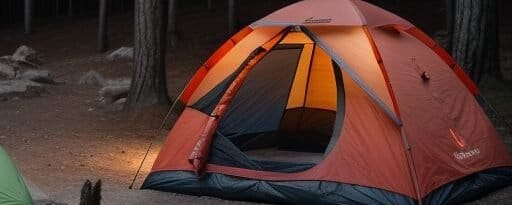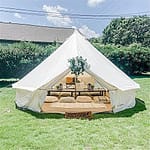The Complete Guide to Glamping Food Storage and Preparation
Imagine sipping wine under the stars, gourmet burger sizzling on the grill, and not a single soggy sandwich or raccoon-raided cooler in sight. Welcome to glamping—where rustic charm meets modern convenience, and food is elevated from canned beans to culinary delight. But even luxury camping comes with its own set of storage and prep challenges. Mastering these can make or break your off-grid (but stylish) gourmet experience.
Glamping vs. Traditional Camping: What’s the Difference?
Unlike traditional camping that often leans into “roughing it,” glamping emphasizes comfort and style. Think queen-sized beds in yurts, string lights in safari tents, and full kitchens in RVs. With great luxury, however, comes greater demand for thoughtful food preparation and storage. You’re no longer just surviving—you’re dining.
Food is central to the glamping experience. Whether you’re whipping up espresso with a portable machine or layering a charcuterie board lakeside, keeping food fresh, organized, and safe is critical. This guide will help you explore the essentials of glamping food storage, from choosing high-efficiency containers to preparing satisfying meals under the stars.
Understanding Glamping-Specific Food Storage Needs
Glamping means access to more amenities, but also different responsibilities. Comfort and convenience are key—many glampers prefer setups that require minimal effort at mealtimes. That means efficient food systems to avoid wasting time digging for spices or chasing rogue apples around a tent.
Safety is another top priority. Semi-outdoor environments invite insects, critters, and fluctuating temperatures. Improper storage can attract pests or cause spoilage, even when you have access to a mini-fridge. Your setup may vary widely depending on whether you’re in a tent, yurt, cabin, or RV—all of which have different storage constraints and amenities.
Choosing the Right Food Storage Containers
Start with airtight and waterproof containers. These protect against moisture, pests, and unwanted smells. Clear containers help you keep track of supplies, while color-coded lids make organization effortless.
Decide between insulated coolers and electric portable fridges. While the latter offers more consistent cooling, they do require a power source. Stackable, space-saving containers can turn even the smallest yurt into a functional pantry. For eco-conscious campers, silicone zip bags, beeswax wraps, and glass jars offer sustainable alternatives to traditional plastic.
Coolers and Portable Refrigeration Solutions
Not all coolers are created equal. Hard-sided versions offer better insulation, while soft-sided varieties are easier to carry. Evaluate your cooling needs based on your trip length and food type. Hybrid electric coolers powered by solar panels or batteries offer the best of both worlds—mobility and reliability.
Keep perishables safe by following ice retention best practices. Pre-chill your cooler, use block ice over cubes, and layer food in order of meal prep. For optimal results, brands like Dometic and ARB offer top-tier portable fridges tried and tested in rugged conditions. “Preventing microbial growth requires keeping perishables below 40°F,” notes the USDA Food Safety and Inspection Service.
Organizing Your Camp Kitchen
A well-organized kitchen streamlines food prep and keeps chaos at bay. Use stackable storage bins and totes specifically labeled for dry goods, utensils, and perishables. Collapsible shelves and hanging organizers maximize vertical space and keep items off damp flooring.
Designate a food prep zone near your cooking area with easy access to cutting boards, spices, and oils. Keep sanitizers and wipe cloths handy to ensure cleanliness, especially when preparing raw meats or using communal surfaces.
Tips for Planning and Packing Glamping Meals
Meal planning is essential. For weekend getaways, pre-prepped meals like marinated kabobs or overnight oats streamline cooking. Longer stays require a balance of fresh, frozen, and non-perishable items to reduce grocery runs.
Prep ingredients at home—chop veggies, cook grains, and portion sauces in advance. Think compact and nutritious: protein bars, canned fish, rice packets, nuts, and dried fruits all perform well. Bring just the right amount to avoid food waste, using portioned containers for staples like pasta or flour.
Cooking Equipment and Their Storage
Store portable stoves, grills, and fuel canisters in fire-retardant, waterproof containers. These should be placed away from direct sunlight and flammable materials. Foldable or nesting equipment cuts down on bulk and integrates seamlessly into glamping setups.
Keep utensils in mesh bags or cutlery rolls for accessibility. Multi-use items like cast iron skillets or double-duty spatulas reduce clutter. Prioritize weatherproof gear storage, particularly in exposed sites where rain or wind could interfere with your kitchen plans.
Keeping Food Safe Outdoors
Use bear-safe or critter-proof containers when storing food outside, even on glamping sites that seem tame. Bungee cords, hard-shell totes, and designated food lockers can help keep your meal supplies safe from wildlife.
Temperature control is vital. Invest in thermometer strips or digital monitors for your cooler or fridge. Wash hands before food prep and use separate boards for produce and meat. When storing leftovers, place them in shallow containers and refrigerate as soon as possible to avoid bacterial growth.
Storage Strategies for Different Weather Conditions
In hot climates, shade your cooler and minimize how often it’s opened. Avoid leaving dairy, meat, or condiments in direct sunlight. In cold weather, prevent freezing by storing perishables inside insulated containers or within temperature-controlled spaces.
Moisture and rain demand extra waterproofing. Seal food in plastic tubs with gaskets or line containers with heavy-duty garbage bags. Use silica gel packs or absorbent dry towels to reduce interior humidity.
Bonus: Glamping-Friendly Storage Hacks
DIY storage projects can make all the difference. Hang a shoe organizer from a tree or tent beam to store spices, utensils, and snacks. Create a mason jar meal station where each jar contains a ready-to-eat dish like salads or granola parfaits.
Vacuum-sealing not only saves space but also extends shelf-life—perfect for meats or marinated items. Roll-out drawers under benches or fold-away furniture can transform unused nooks into clever pantry solutions. Get creative with your space and materials—it’s half the fun of glamping!
Final Thoughts
Elevating your food storage and preparation game turns glamping meals into memorable highlights rather than logistical headaches. Choose smart storage solutions, plan meals thoughtfully, and always prioritize safety. Whether you’re relaxing in an upscale tent or road-tripping in a fully-loaded RV, a little preparation goes a long way.
The best glamping experiences are those that combine form and function. Take the time to test your setup before heading out. And don’t forget—your readers want to hear from you! Leave a comment sharing your favorite glamping food storage tip or hack.
“`











